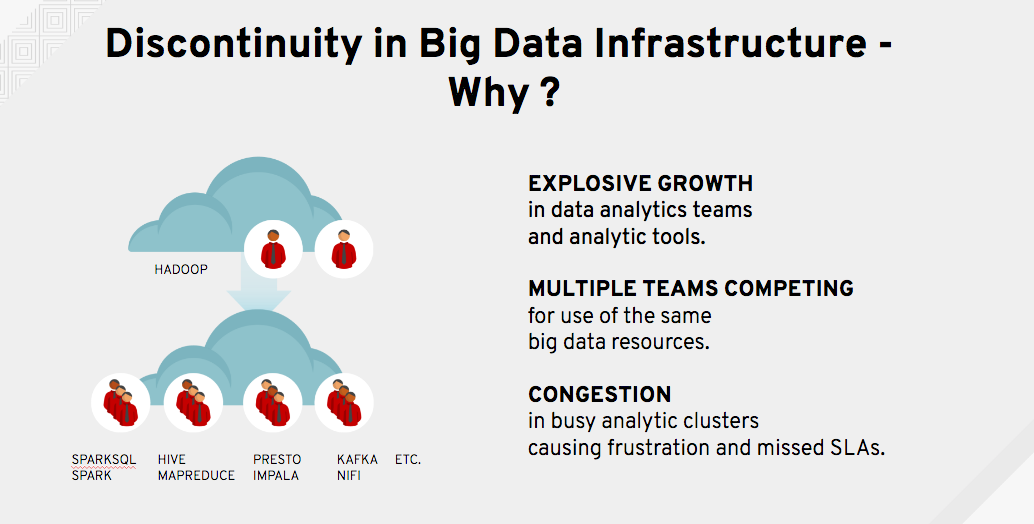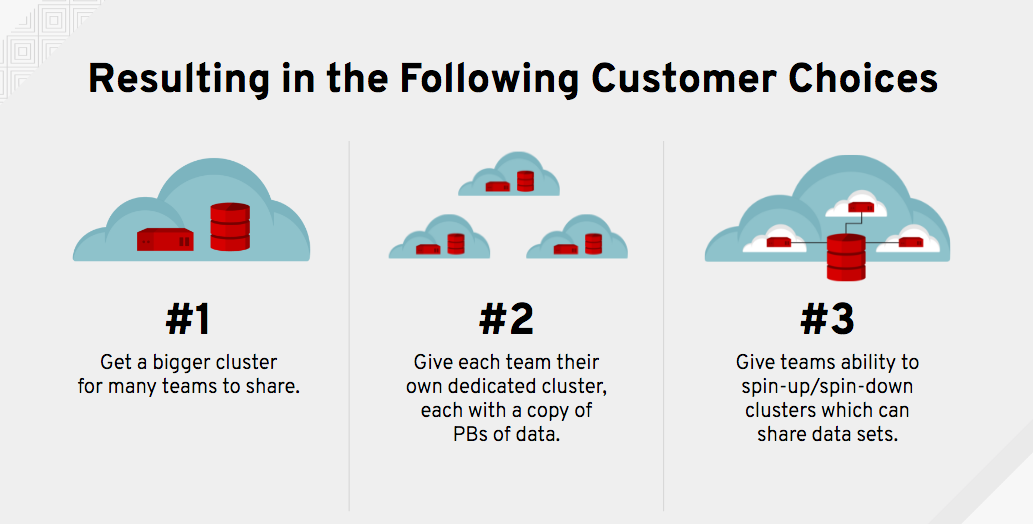A couple years ago, a few big companies began to run Spark and Hadoop analytics clusters using shared Ceph object storage to augment and/or replace HDFS.
We set out to find out why they were doing it and how it performs.
Specifically, we wanted to know first-hand answers to the following three questions:
- Why would companies do this? (this blog post)
- Will mainstream analytics jobs run directly against a Ceph object store? (see "Why Spark on Ceph? (Part 2 of 3)")
- How much slower will it run than natively on HDFS? (see "Why Spark on Ceph? (Part 3 of 3)")
We’ll provide summary-level answers to these questions in a 3-part blog series. In addition, for those wanting more depth, we’ll cross-link to a separate reference architecture blog series providing detailed descriptions, test data, and configuration scenarios, and we recorded this podcast with Intel, in which we talk about our focus on making Spark, Hadoop, and Ceph work better on Intel hardware and helping enterprises scale efficiently.
Part 1: Why would companies do this?
Agility of many, the power of one.
The agility of many analytics clusters, with the power of one shared data store.
(Ok ... enough with the simplistic couplets.)
Here are a few common problems that emerged from speaking with 30+ companies:
- Teams that share the same analytics cluster are frequently frustrated because someone else’s job often prevents their job from finishing on-time.
- In addition, some teams want the stability of older analytic tool versions on their clusters, while their peer teams need to load the latest-and-greatest tool releases.
- As a result, many teams demand their own separate analytics cluster so their jobs aren’t competing for resources with other teams, and so they can tailor their cluster to their own needs.
- However, each separate analytics cluster typically has its own, non-shared HDFS data store - creating data silos.
- And to provide access to the same data sets across the silos, the data platform team frequently copies datasets between the HDFS silos, trying to keep them consistent and up-to-date.
- As a result, companies end up maintaining many separate, fixed analytics clusters (50+ in one case), each with their own HDFS data silo containing redundant copies of PBs of data, while maintaining an error-prone maze of scripts to keep data sets updated across silos.
- But, the resulting cost of maintaining 5, 10, or 20 copies of multi-PB datasets on the various HDFS silos is cost prohibitive to many companies (both CapEx and OpEx).
In pictures, their core problems and resulting options look something like this:
Turns out that the AWS ecosystem built a solution for choice #3 (see Figure 2 above) years ago through the Hadoop S3A filesystem client. In AWS, you can spin-up many analytics clusters on EC2 instances, and share data sets between them on Amazon S3 (e.g. see Cloudera CDH support for Amazon S3). No more lengthy delays hydrating HDFS storage after spinning-up new clusters, or de-staging HDFS data upon cluster termination. With the Hadoop S3A filesystem client, Spark/Hadoop jobs and queries can run directly against data held within a shared S3 data store.
Bottom-line ... more-and-more data scientists and analysts are accustomed to spinning-up analytic clusters quickly on AWS with access to shared data sets, without time-consuming HDFS data-hydration and de-stage cyles, and expect the same capability on-premises.
Ceph is the #1 open-source, private-cloud object storage platform, providing S3-compatible object storage. It was (and is) the natural choice for these companies looking to provide an S3-compatible shared data lake experience to their analysts on-premises.
To learn more, continue to the next post in this series, "Why Spark on Ceph? (Part 2 of 3)": Will mainstream analytics jobs run directly against a Ceph object store?
저자 소개
채널별 검색
오토메이션
기술, 팀, 인프라를 위한 IT 자동화 최신 동향
인공지능
고객이 어디서나 AI 워크로드를 실행할 수 있도록 지원하는 플랫폼 업데이트
오픈 하이브리드 클라우드
하이브리드 클라우드로 더욱 유연한 미래를 구축하는 방법을 알아보세요
보안
환경과 기술 전반에 걸쳐 리스크를 감소하는 방법에 대한 최신 정보
엣지 컴퓨팅
엣지에서의 운영을 단순화하는 플랫폼 업데이트
인프라
세계적으로 인정받은 기업용 Linux 플랫폼에 대한 최신 정보
애플리케이션
복잡한 애플리케이션에 대한 솔루션 더 보기
오리지널 쇼
엔터프라이즈 기술 분야의 제작자와 리더가 전하는 흥미로운 스토리
제품
- Red Hat Enterprise Linux
- Red Hat OpenShift Enterprise
- Red Hat Ansible Automation Platform
- 클라우드 서비스
- 모든 제품 보기
툴
체험, 구매 & 영업
커뮤니케이션
Red Hat 소개
Red Hat은 Linux, 클라우드, 컨테이너, 쿠버네티스 등을 포함한 글로벌 엔터프라이즈 오픈소스 솔루션 공급업체입니다. Red Hat은 코어 데이터센터에서 네트워크 엣지에 이르기까지 다양한 플랫폼과 환경에서 기업의 업무 편의성을 높여 주는 강화된 기능의 솔루션을 제공합니다.



